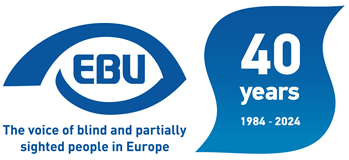Accessibility of lifts – Usability for persons with visual impairment.
Why we are campaigning
In relation to the accessibility of lifts, lack of awareness regarding the importance of measures that allow people with a visual impairment to use lifts autonomously is a big problem. While it is broadly understood and accepted that certain specific requirements such as access without steps, a minimum door width or enough space inside the lift car are necessary requirements, it is not yet widely accepted that, for example, the usability of control devices is just as necessary to ensure the accessibility of the whole lift. Therefore, people with visual impairment often experience serious difficulties in using lifts.
Campaign History
Our campaign started around the updating of the requirements for accessibility of lifts set on a European level (EN 81-70). Since there have been concerns that the new requirements might not be sufficient in relation to users with visual impairment, EBU has campaigned extensively with its partners on this topic. Although this has been partly successful, there is still a lot of work to do to ensure the accessibility of lifts through sufficient requirements in standardisation and legislation as well as awareness raising among all stakeholders. The revised standard for accessible lifts (CEN 81-70:2018), published on 16 May 2018, was disappointing, inter alia due to insufficient contrast requirements for operating buttons.
Our hopes then rested on the perspective of a revision of Lifts Directive. Unfortunately we learned in December 2018 that, based on the final report on the evaluation of the Directive, the European Commission found that there was no reason to revise it. However, we were invited to provide the Commission with a technical position paper explaining why we feel the revised EU standard for accessible lifts does not meet the test of universal design, before the Commission proceeds with the publication of its reference in the OJ.
In our technical position paper, sent to the Commission on 28 February after consulting with our partners ANEC and EDF, we argued that the revised standard:
- did not provide sufficient guidance for the implementation of lifts to be used by the widest possible range of users (including blind and partially sighted persons) and to meet the requirements of the UNCRPD, and fails to respect Recital (20) of the Lifts Directive and Article 1.6 of Annex I thereto;
- did not seriously take into account the views of societal stakeholders, namely the advice provided by user/consumer organisations representing blind and partially sighted persons.
We asked the Commission to refrain from proceeding with the publication of CEN 81-70:2018 in the Official Journal, or otherwise to do so with a restrictive notice to show that certain clauses of the standard do not provide a presumption of conformity with the legislation. Incidentally, we argued that it would be appropriate to include the lifts accessibility requirements of EN 81-70 in the lifts safety requirements of EN 81-20, as the latter is much more widely respected by the industry in practice.
On 6 March 2019 the European Commission’s relevant unit informed us that they had rejected the publication of references of EN 81-70:2018 in the Official Journal of the EU under Directive 2014/33/EU on lifts and safety components for lifts, and that a likely consequence is that CEN will need to further improve the standard. In doing so, the Commission expects CEN to “carefully listen to all concerned parties”. Presumably our expressed concerns weighted in this positive outcome, although the Commission’s decision was motivated more largely by “a number of issues related to compliance of EN 81-70 with the Commission Standardisation Request M/549 and the applicable drafting rules for standards”.
The current situation
(Page updated 24/08/2022)
September 2021 – CEN approved EN 81-70:2021/prA1, the technical revision of the Accessibility to lifts standard EN 81-70:2018. This incorporates the amendments for now satisfactory colour contrast requirements, following the ANEC appeal and subsequent work, within the relevant working group of CEN, in which EDF and EBU were closely involved by ANEC.
Next Steps
In follow-up to the positive result described above, we will continue to follow the ongoing revision of the accessible lifts standard.
In the longer term, the aim will be to have sufficient accessibility requirements included in the basic lift standard EN 81-20 instead of having a separate standard for accessibility, which is not even applied at the moment in most European countries. In January 2022 we expressed full support for the ANEC (then still draft) comments regarding the European Commission’s new standardisation request as regards lifts and safety components for lifts in support of Directive 2014/33/EU. This is in line with previously agreed positions, inter alia on the relationship between EN 81-20 (general safety standard on passenger and goods lifts) and EN 81-70 (accessibility to lifts standard). Concretely, we are mindful that EN 81-20 is the standard that the industry takes most seriously, whereas they tend to neglect EN 81-70. So, we ask for Annex II to the standardisation request to require that “all standards” concerning lift to be reviewed or created take into account accessibility in line with the UN CRPD, including EN 81-20. Furthermore, in revising the accessible lifts standard, we will want to raise awareness about the lack of accessibility of several solutions that are already on the market and implemented (e.g. sensor and touch screen devices) and demand to either improve or avoid them.
In general, we will want to address the issue of actual participation in standardisation processes in order to achieve standards that comply to accessibility following a Design for All approach in the future. EBU will support ANEC’s approaches providing the strong voice and expertise of VI persons’ advocacy group and collaborating with other organisations such as EDF and AGE.
More information
Further reading :
More details on the European Standard EN 81-70:2003
Press releases and position papers:
Position paper - Accessibility of Lifts: Why the European standard EN 81-70:2018 fails to meet the legal requirements, (February 2019)

